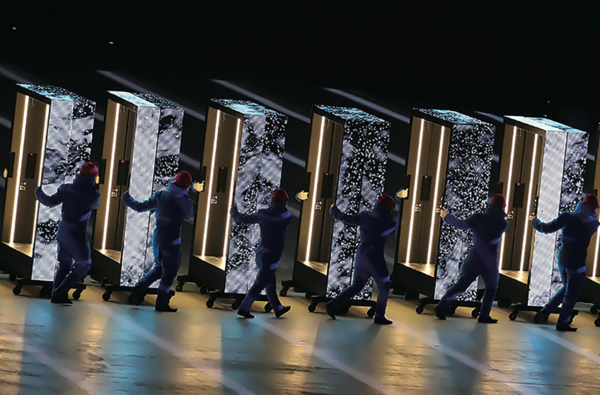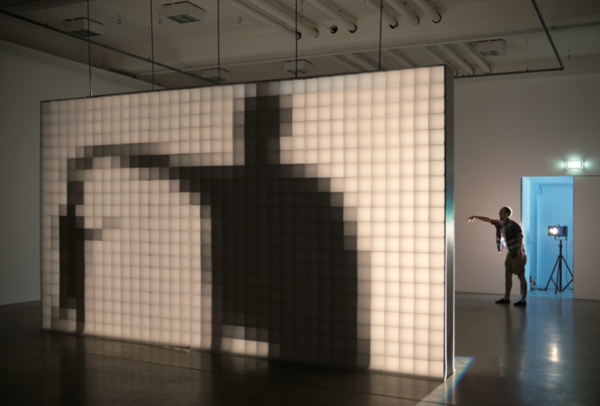On October 15th, the 2023 Gwangju Media Art Festival, a showcase of domestic and international artists, was held and received a favorable reception. With its unique characteristics, digital art has become a significant component of contemporary art, as hinted by the growing number of exhibitions. The Sungkyun Times (SKT) will therefore investigate the origins of digital art, as well as its constraints and the envisioned future direction.
Combining Art and Technology
-The Rise of Digital Art
Digital art refers to artistic activities in various fields, such as sculpture, painting, and installation using digital media, and is also called as multimedia art, web art, and net art. The roots of digital art can be traced back to the late 1980s and early 1990s, coinciding with the rapid development of computers and the internet. Domestically, Paik Nam-june’s groundbreaking video art profoundly impacted digital art’s development. Since 1995, Paik has been at the forefront of using computers to merge video and images in Korea, notably creating innovative installations that ushered in the digital era. Subsequently, South Korea’s first digital art museum, Art Center Nabi, was opened in 2001, and it initiated the Nabi Artist Residency Program. The program was aimed at supporting emerging digital artists, thereby pioneering the domestic digital art market. In the ongoing era of rapid developments in both art and technology, along with the escalating interest in digital art, the proliferation of exhibitions focused on digital art persists. Consequently, the digital art market is expanding and is projected to surpass a ₩1 trillion market share for the first time in 2023, according to the Ministry of Culture, Sports, and Tourism.
-Digital Art’s Defining Characteristics
Digital art is characterized by the use of digital media over traditional art tools in the fields of design, video, and music. For instance, the opening ceremony of the PyeongChang 2018 Winter Olympics, Door of the Future, incorporated 120 light-emitting diode (LED) media and performance elements, showing the broad spectrum of digital art. In fact, the uniqueness of digital art is from prior innovative methods as it is crafted through diverse combinations facilitated by computer programs. The use of computers also accelerates the production process, which previously took a considerable amount of time, and transmits the artwork to a wider audience due to its duplicability. These features thereby formed a new creative environment where artworks can be easily shared among various artists and audiences. Nowadays, digital art is rapidly evolving into a groundbreaking field in the art world, opening new dimensions of contemporary art.

The Dual Nature of Digital Art
-Expanded Creation Space for Digital Art
Digital art has unique advantages compared to traditional art forms. First, digital art can harness a wide range of methods and mediums, fostering creativity and freedom. Beyond traditional art forms, digital art can be used to express ideas in new ways, particularly when utilizing space, allowing the exhibition space itself to become a work of art. For example, Gwanghwamun Square presented an exhibition using the walls of a building as a screen. Kang Hye-ri, an instructor at SBS Academy Computer Arts Institute, said, “There are various directions in that many students are interested in the use of digital art,” in an interview with the SKT. In addition, digital art has the characteristics of interactive art that allows the audience to directly participate in the work. This feature indicates that the artwork can only be completed through audience participation. A student from the Department of Film, Television, and Multimedia who visited the Miguel Chevalier Digital Beauty Exhibition told the SKT that, “The change in organic patterns on the floor coordinated with the movement of the visitors made me feel like I was creating an artwork.”

-Preservation Puzzle and Copyright Conflict
Despite its many advantages, digital art faces unsolved technical challenges and copyright issues. In the case of digital art that relies on hardware, it may encounter technical problems over time; however, preservation methods have not yet been fully developed. Since preservation is more than simply replacing parts, an improper method may damage the piece. In 2022, the National Museum of Modern and Contemporary Art replaced the monitors of Paik’s video art The More, The Better with LEDs and reactivated them after four years, but one of the monitors turned off within five minutes due to technical deficiencies. Digital art relying on software also faces different kinds of preservation problems. File corruption caused by upgrades and compatibility between programs are the main issues. When a version of a particular graphics software changes, it may not support older file formats, making it challenging to present the artwork. In addition to technical issues, digital art grapples with the significant problem of unauthorized copying and uploading to non-fungible tokens (NFT). Regarding copyright, digital art stored as digital image files such as JPEGs and PNGs is particularly vulnerable to copyright infringement since the format eases the copying without authorization. The use of NFTs has proliferated to combat the issue, but the risk still remains. In fact, there have been cases where people who have not gained the right to utilize offline artworks sold them as NFTs. For instance, in 2022, an auction house in Korea issued an NFT of an actual work by artist Lee Jong-seok without getting permission from the holder, resulting in the cancellation of the auction. Furthermore, due to the opaque nature of digital art transactions, ownership issues often arise during the transfer process, including confusion over whether the right to create secondary works is transferred.
To Develop the Digital Art Market
-Resolving Constraints in Art
Since digital art is an integral part of contemporary art, solutions to preservation and copyright issues are constantly being sought. Preserving the historical originality of artworks is important, but replacing hardware to ensure sustainability is also crucial. Hence, art museums should contemplate reforming their current conservative attitudes, as they are often overly focused on preserving originality. To address digital art’s hardware and software problems, a device to back up and update the artwork is strongly needed. This can be achieved through emulation, a program in which one system on a computer works by replicating and imitating another system. Emulation will make past media viewable without program compatibility issues. In addition, securing the environment for NFT and digital art is required. This includes the verification of authorship by providing proof of the original work or production process. If a third party utilizes digital artwork in a commercial way, the production rights should be carefully checked to prevent unauthorized copying or illegal activities. Copyright transfer issues can be tackled by using licensing agreements that grant or restrict the use of property rights. A licensing agreement can address the moral rights issue by specifying the termination of the contract and the purpose of the right.
-Prospect for Digital Art
Digital art contains endless possibilities. The art industry is expected to further expand due to the development of online platforms. Unlike traditional art, digital art is open to various opportunities such as collaboration with brands, and is relatively easy to commercialize. For instance, BMW Korea recently organized the BMW Vantage Joy Mall Art Fair with digital artists and provided a service that allows customers to purchase artwork that fits their lifestyle online. The targeted Millennials is in fact the largest and most active collector of digital art, which can strengthen the cooperation between digital art and cultural businesses. For instance, the Arte Museum, the largest immersive digital art exhibition center in Korea, has established itself as a leading tourist attraction in various regions, experiencing a 42% increase in sales in 2023 compared to the previous year. Furthermore, collaboration with the arts and culture sector will further expand the realm of digital art.

Digital art is expected to become more advanced and accessible in the future. However, with the benefits of the digital art market come the challenges of preservation and copyright issues. Kingos should continue to be actively interested in the digital art market, all the while conscientiously contributing to its positive development.
